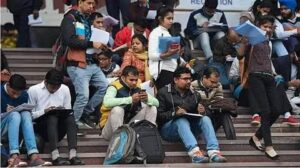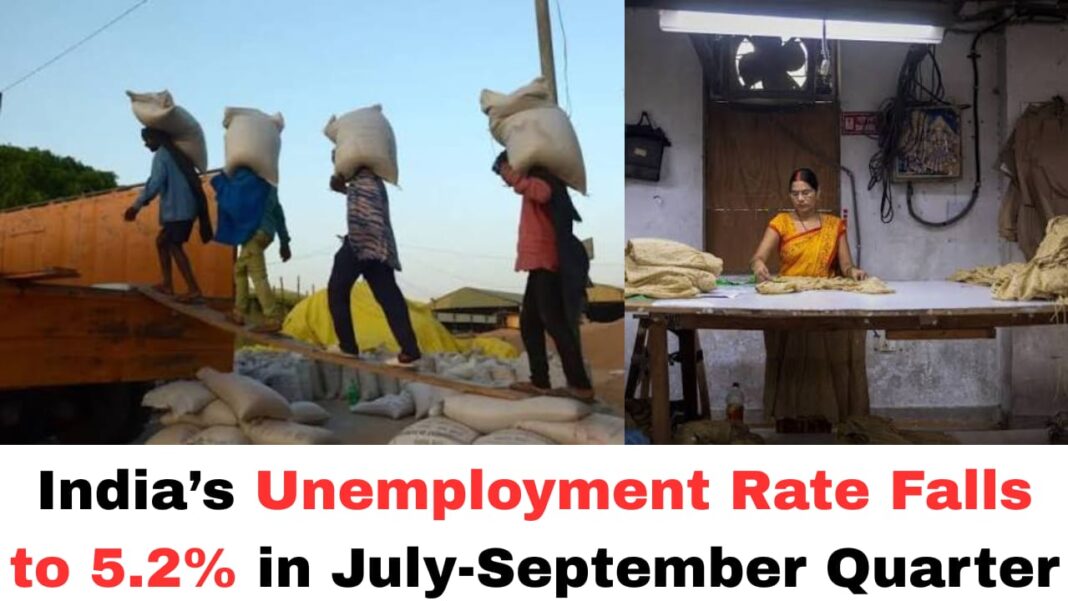Digital News Guru National Desk:
India’s Unemployment rate falls to 5.2% but structural issues remain
India’s labour market has shown a modest improvement in the second quarter of fiscal year 2025-26 (July-September 2025), with the official unemployment rate declining to 5.2% from 5.4% in the previous quarter. The data, released by the Ministry of Statistics and Programme Implementation (MoSPI) under the Periodic Labour Force Survey (PLFS), suggests some recovery in rural employment, but also highlights persistent structural issues—especially in urban areas and among youth.
What the numbers show
The overall unemployment rate for persons aged 15 years and above fell to 5.2% in Q2 FY26 (July–September) from 5.4% in Q1. Breaking it down:
- In rural areas, the jobless rate dropped from 4.8% to 4.4%.
- In urban areas, however, unemployment ticked up slightly from 6.8% to 6.9%.

- The labour force participation rate (LFPR) edged up to 55.1% from 55.0%.
- Female labour force participation increased to 33.7% from 33.4%.
- The Worker Population Ratio (WPR)—the share of employed persons in the total population—rose marginally to 52.2%.
These data points depict a broad, but superficial, improvement: more people participating in the labour market and fewer people formally counted as unemployed.
What is driving the drop
The decline in unemployment is largely attributed to stronger activity in rural areas, particularly from seasonal agricultural work and increased self-employment. The share of the rural workforce engaged in agriculture rose to 57.7% from 53.5%. In rural regions the share of self-employed workers climbed to 62.8% from 60.7%. Thus during the kharif harvest season, labour demand in farming seems to have given the rural job market a short-term boost.
In urban areas there was a marginal improvement in regular wage or salaried employment, rising to 49.8% from 49.4%. The tertiary (services) sector also remained dominant in urban employment at 62.0%. These numbers suggest some diversification of employment in urban India—but only modestly so.
The cracks beneath the surface
Despite the encouraging headline, several concerning features remain:
Urban employment stress: The rise in urban unemployment, albeit modest, signals that job creation in cities is still lagging. This is troubling given that urban areas are expected to absorb many of the first-time job seekers and migrant workers.
Youth unemployment: For people aged 15–29 (first‐time entrants to the labour market), the unemployment rate rose marginally to 14.8% from 14.6%. A high youth jobless rate is a key indicator of structural unemployment and labour market disequilibrium.

Quality and nature of jobs: The rise in self-employment—especially in rural areas—may indicate more precarious work rather than stable employment with social security or benefits. With agriculture absorbing more workers seasonally, there is the risk of under-employment or informal work.
Data-quality questions: Independent economists remain sceptical of the official data’s accuracy. According to a recent poll, many believe the real jobless rate may be closer to double the reported figure because definitions of employment are broad (for example, someone working even one hour in a week is counted as employed).
Implications for policy and economy
The mixed nature of the data suggests that while the employment situation may be stabilising, policymakers cannot afford complacency. Here are key implications:
- Need for formal, quality job creation
The focus should shift to generating sustainable formal employment in manufacturing and services, not just temporary or seasonal work. Urban labour markets, in particular, need robust job creation engines. - Target youth labour force
Given high youth unemployment, interventions such as vocational training, skill up-gradation, internships, and job linkage become even more critical. Without these, a large cohort of young Indians may remain trapped in low-quality or informal work. - Improve data and job-market diagnostics
Reliable employment data, including on under-employment, job quality, and informal work, are essential for targeted policy. The broad definitions currently used may mask deeper labour market vulnerabilities. - Strengthen rural–urban employment linkage
While rural job growth is welcome, India must avoid a bifurcated labour market where rural areas absorb seasonal or informal work while urban areas stagnate. Balanced growth across geographies is key. - Women’s labour force participation
The upward trend in female participation is positive but still low for global standards. Incentives, flexible work, safety, and social norms continue to affect women’s labour market engagement.
The bottom line
The drop in unemployment to 5.2% is a positive signal, particularly for rural India and female workforce participation. However, the story behind the numbers suggests caution. Urban areas remain constrained, youth unemployment is stubborn, and a rising share of jobs are informal or seasonal – all clear signs that India’s employment challenge remains deep and structural.
As India moves deeper into 2026, the key questions will be: Can the country move from quantity of jobs (getting people employed) to quality of jobs (secure, productive employment)? Can urban job creation be ramped up to match rural gains? And can youth and women be meaningfully integrated into the workforce? The answers will be central to India’s broader economic and social aspirations.
You May Also Read: Anupama Parameswaran Files Cyber-Complaint After Online Harassment by 20-Year-Old









